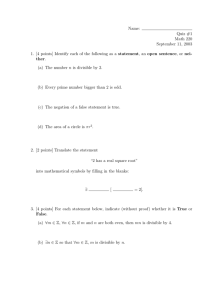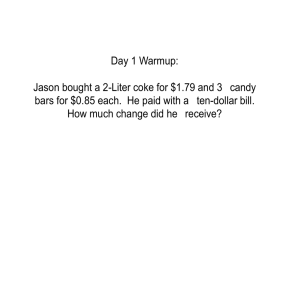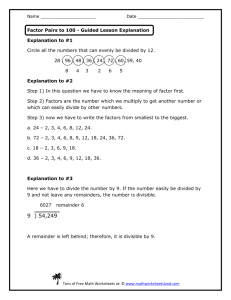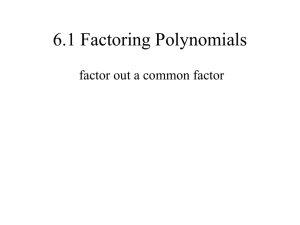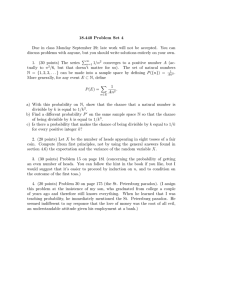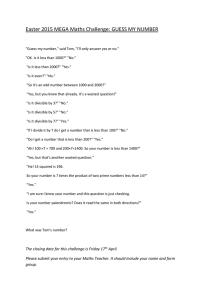Math 165, Section D Professor Lieberman QUIZ #5 Question:
advertisement
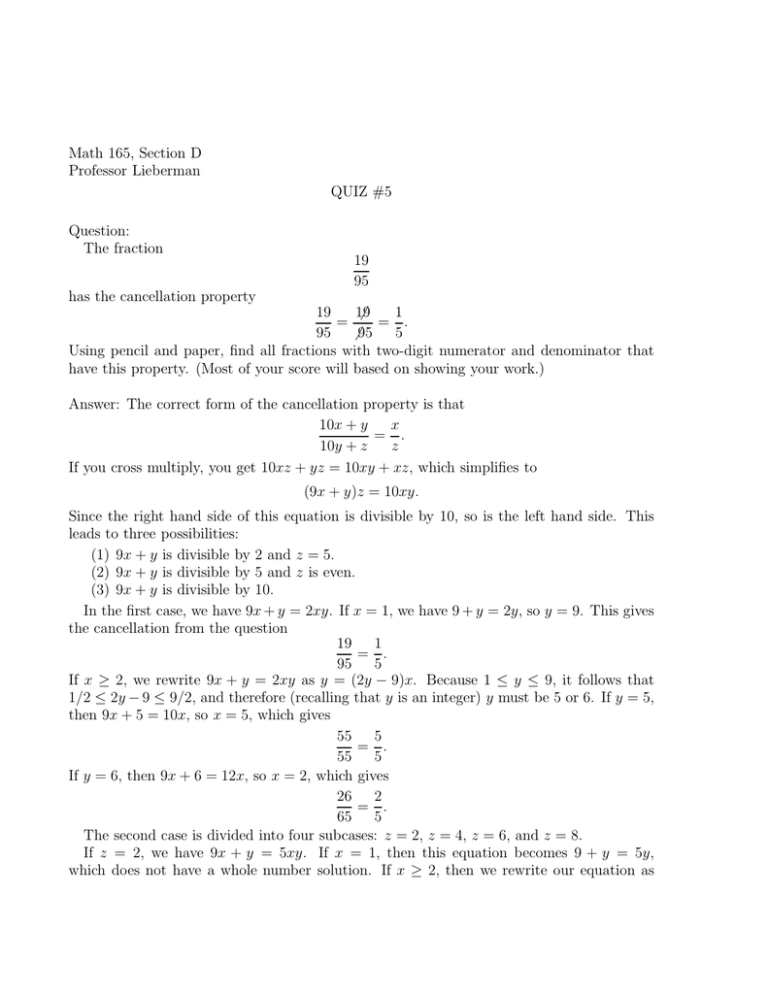
Math 165, Section D Professor Lieberman QUIZ #5 Question: The fraction 19 95 has the cancellation property 16 9 1 19 = = . 95 6 95 5 Using pencil and paper, find all fractions with two-digit numerator and denominator that have this property. (Most of your score will based on showing your work.) Answer: The correct form of the cancellation property is that 10x + y x = . 10y + z z If you cross multiply, you get 10xz + yz = 10xy + xz, which simplifies to (9x + y)z = 10xy. Since the right hand side of this equation is divisible by 10, so is the left hand side. This leads to three possibilities: (1) 9x + y is divisible by 2 and z = 5. (2) 9x + y is divisible by 5 and z is even. (3) 9x + y is divisible by 10. In the first case, we have 9x + y = 2xy. If x = 1, we have 9 + y = 2y, so y = 9. This gives the cancellation from the question 19 1 = . 95 5 If x ≥ 2, we rewrite 9x + y = 2xy as y = (2y − 9)x. Because 1 ≤ y ≤ 9, it follows that 1/2 ≤ 2y − 9 ≤ 9/2, and therefore (recalling that y is an integer) y must be 5 or 6. If y = 5, then 9x + 5 = 10x, so x = 5, which gives 55 5 = . 55 5 If y = 6, then 9x + 6 = 12x, so x = 2, which gives 26 2 = . 65 5 The second case is divided into four subcases: z = 2, z = 4, z = 6, and z = 8. If z = 2, we have 9x + y = 5xy. If x = 1, then this equation becomes 9 + y = 5y, which does not have a whole number solution. If x ≥ 2, then we rewrite our equation as 2 y = (5y − 9)x. Therefore 1/2 ≤ 5y − 9 ≤ 9/2, so 19/10 ≤ y ≤ 27/10, which means y = 2 and then 9x + 2 = 10x, which means also x = 2. Therefore we obtain 2 22 = . 22 2 If z = 4, our equation is 9x + y = (5/2)xy. If also x = 1, we find that y = 6, and we have 16 1 = . 64 4 If x ≥ 2, then 1/2 ≤ (5/2)y − 9 ≤ 9/2, so y = 4 or y = 5. If y = 4, then x = 4, so we obtain 44 4 = . 44 4 If y = 5, then the equation 9x + 5 = (25/2)x doesn’t have a whole number solution. If z = 6, our equation is 9x + y = (5/3)xy. This equation doesn’t have a whole number solution for x = 1, so we can directly consider x ≥ 2, which means 1/2 ≤ (5/3)y − 9 ≤ 9/2. Therefore 57/10 ≤ y ≤ 81/10 or y = 6, 7, 8. If y = 6, then x = 6, which yields 66 6 = . 66 6 The corresponding equations for y = 7 and y = 8 do not have whole number solutions. If z = 8, our equation is 9x + y = (5/4)xy. The equation with x = 1 has the solution y = 36, which is too big, so we can go to x ≥ 2. Then 1/2 ≥ (5/4)y − 9 ≤ 9/2, so y = 8 or y = 9. If y = 8, then x = 8, which gives 88 8 = . 88 8 If y = 9, then x = 4, which gives 49 4 = . 98 8 Finally, if 9x + y is divisible by 10, so is y − x (because y − x = 9x + y − 10x). Since x and y are single digits, it follows that x = y, and the original equation (9x + y)z = 10xy tells us that also z = x. Some of these cases have already been listed. The others are: 1 33 3 77 7 99 9 11 = , = , = , = . 11 1 33 3 77 7 99 9 Therefore, there are 13 fractions with the cancellation property.
